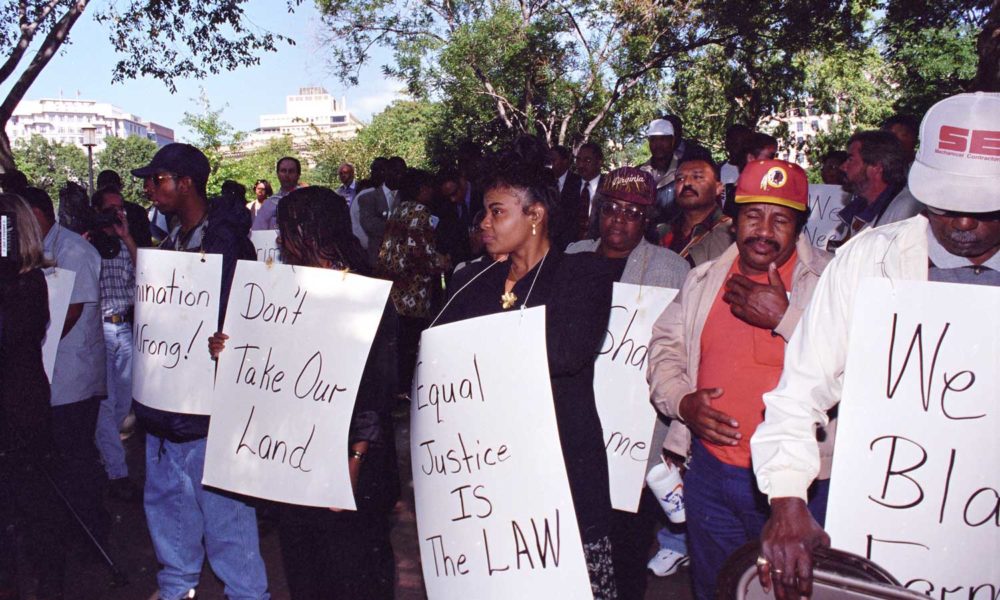As the descendants of enslaved people in the United States celebrate Juneteenth this weekend, the date (June 19) has taken on a new significance. This week, Congress voted suddenly and overwhelmingly to grant official federal holiday status to the day commemorating the end of slavery in Texas in 1865, two and a half years after President Lincoln issued the Emancipation Proclamation. Like freedom itself, the holiday designation has been a long time coming, and so too has justice—in so many forms—for Black people in this country.
For Black farmers celebrating Juneteenth, this new federal holiday may be bittersweet. Even as more people recognize the long legacy of slavery in this country, efforts to address decades of land loss and discrimination against Black farmers continue to be delayed.
40 acres and a promise unfulfilled
Injustice has been intertwined with agriculture since the beginning of this country. In the antebellum South, millions of enslaved men and women toiled on plantations, planting and harvesting cotton, tobacco, rice, and other agricultural commodities for wealthy white landowners. By 1860, there were 4 million enslaved people in the United States, some 60 percent of whom worked in cotton.
Emancipation after 247 years of chattel slavery marked the beginning of a new period of hardship and struggle for formerly enslaved Black farmers. In January 1865, a group of Black leaders met with General William T. Sherman in Savannah, Georgia, to make the case that real freedom required access to land—the primary means of survival in a largely agrarian society. They persuaded him to issue Special Field Order Number 15, known widely as the promise of “40 acres and a mule” (though in fact mules do not appear in the text). Sherman’s order set aside 400,000 acres of confiscated Confederate land for freed Black farmers, to be divvied up into small plots and distributed to Black families. But the government ultimately failed to deliver on that promise, and Sherman’s order was overturned by President Andrew Johnson after Lincoln’s assassination.
In the years after emancipation, formerly enslaved Black farmers struggled to prosper under the new exploitative arrangements of sharecropping. Some managed to save enough money to buy or rent their own land, though many more went into debt or remained stuck in the sharecropping system with little hope of something better.
A century of land loss and discrimination
Still, in 1920, Black farmers accounted for 14 percent of all US farmers, collectively owning approximately 15 million acres of farmland. But in a 2019 post on this blog, my colleague chronicled what happened next—how US agriculture gradually became consolidated, industrialized, and unrelentingly White over the course of the 20th century, as institutional racism and antiquated property laws drove massive Black land loss. By 1982, Black farmers represented less than 2 percent of the nation’s 2.2 million farmers. And by 2017, that number was down to 1.6 percent.
In our recent study, Losing Ground, we found that consolidation of US farmland into ever-fewer hands—a trend that is ongoing—has hurt small and beginning farmers across the board but has been especially bad for Black farmers, with greater consolidation associated with a greater loss of Black farmers, compared to other states. Moreover, an entrenched culture of discrimination at the US Department of Agriculture has held Black farmers back, denying them loans and other assistance for decades.
Justice hits another roadblock
So it was with justified skepticism that Black farmers met the Biden administration’s new secretary of agriculture earlier this year. Returning to the USDA for a second act, Secretary Vilsack was seen as having failed to live up to promises of a new era of civil rights during his tenure at the department in the Obama administration.
Still, Vilsack’s pledges to root out discrimination and a new civil rights policy statement offered new hope, as did the introduction in late 2020 of the Justice for Black Farmers Act in the Senate. The bill seeks to reform the USDA, provide debt relief, and create a land grant program to encourage a new generation of Black farmers. And in early March, the debt relief provision of the bill was taken up as part of COVID-19 relief spending in the $1.9 trillion American Rescue Plan Act, passed by Congress, and signed by President Biden.
Earlier this year, the House agriculture committee held a hearing on the state of Black farmers in the United States, and witnesses spoke eloquently and sometimes painfully about the challenges they’ve faced. Providing debt relief and halting foreclosures for Black farmers and other farmers of color isn’t enough, on its own, to right all the wrongs. But it’s a start.
In May, the USDA announced that the first debt relief checks would roll out in early June. And the backlash followed quickly. First the big banks complained—with an amount of gall that was surprising even for big banks—that the program would cost them future income they had long counted on and were entitled to. Then the lawsuits began: a white cattle rancher in Montana, a white Florida farmer, and a group led by odious former Trump aide Stephen Miller have all sued, charging reverse discrimination. And although the USDA had already paid out more than half the estimated $4 billion debt relief fund, last week a Wisconsin judge temporarily halted the program while the legal challenges are pending.
Secretary Vilsack has pledged to vigorously defend the program. And 150+ organizations have written a letter decrying the lawsuits and the temporary restraining order. Led by the Intertribal Agriculture Council, the Rural Coalition, and the North Carolina Association of Black Lawyers Land Loss Prevention Project, the letter doesn’t mince words:
No serious observer of USDA’s role in American agriculture can doubt that the Department has engaged in decades of intentional, and systematic, discrimination based on race and ethnicity. The results have been catastrophic and have completely reshaped farming by eliminating a wide swath of farmers. If ever there was a constitutional basis for taking race into account when making policy this is it. In its decision the Court appears oblivious to this history, and hostile to efforts to achieve true racial justice.
It remains to be seen whether the courts will conclude that there is a compelling government interest in reversing the USDA’s long and ugly history of discrimination against farmers of color. As we recognize the official Juneteenth holiday as another small step in this country’s racial reckoning, Black farmers will be hoping there is much more to come.

